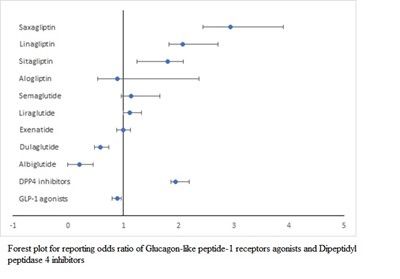Article
Prescribing in T2D: What Providers Look for in Drugs, Protective Effects of GLP-1 RAs, Other Data Presented at AHA
Author(s):
Data about prescribing preferences and protective effects of GLP-1 receptor agonists in diabetes were presented on the opening day of the 2021 American Heart Association Scientific Sessions, held in a virtual format.
Data about prescribing preferences and protective effects of glucagon-like peptide-1 receptor agonists (RAs) in diabetes were presented on the opening day of the 2021 American Heart Association Scientific Sessions, held in a virtual format.
CV risk reduction more important than side effects in T2D. US health care providers who took part in a study about preferences for prescribing medications to treat T2D said risk reduction mattered more than limiting side effects. The study, PREFER-DM, was based on an online survey sent to 12,806 providers; 1052 submitted responses. Those responding included 350 endocrinologists (33%), 337 cardiologists (32%), and 365 primary care physicians (35%). The survey asked providers about attributes they look for in medications; the attributes were gleaned from recent phase III studies and FDA labels for empagliflozin 25 mg, a sodium glucose co-transporter 2 (SGLT2) inhibitor; oral semaglutide 14 mg, a GLP-1 RA; and sitagliptin, a dipeptidyl peptidase-4 (DPP-4) inhibitor. Providers were asked to select from 6 hypothetical, blinded drug profile comparisons of various cardiovascular (CV) benefits and side effects. “The relative importance of one attribute relative to another was calculated,” the authors said.
A drug’s ability to reduce risk of CV death was the most important attribute. Providers gave equal weight to a drug’s ability to reduce effects of heart failure (HF), the risk of nausea, the ability to slow renal disease, and weight reduction. Food restrictions and a drug’s ability to reduce glycated hemoglobin (A1C) were given less importance, followed by risk of diabetic ketoacidosis, avoiding severe hypoglycemia, and risk of genital infection. “Whether these preferences translate to prescription patterns and patient acceptance of oral antihyperglycemic drugs in clinical settings remains to be investigated,” the authors said.
Reference
Sharma A, Fudim M, Greene SJ, et al. Provider evaluation for selection of evidence-based therapies to reduce cardiovascular complications in patients with type 2 diabetes mellitus study: primary results of the PREFER-DM Study. Presented at the 2021 American Heart Association Scientific Sessions, Virtual, November 13, 2021. Abstract 228.
GLP-1 RA class reduces risk of atrial fibrillation. Researchers from Louisiana State University in Shreveport hypothesized that GLP-1 RAs and DPP-4 inhibitors may have a protective effect in atrial fibrillation (AF), but data have been limited. Using the FAERS database (FDA Adverse Event Reporting System), they identified 159,901 and 44,072 AEs reported on the GLP-1 RA and DPP-4 inhibitor groups, respectively. Reporting of AF was significantly lower for GLP-1 RA compared to all other drugs in FAERS (reporting odds ratio [ROR] 0.56; 95% CI 0.49-0.63). In this data set, AF was significantly higher in DPP-4 inhibitor therapies (ROR 2.02; 95% CI 1.76-2.33). Saxagliptin had the highest AF reporting (ROR 2.67; 95% CI 2.00-3.57), followed by linagliptin (ROR 1.87; 95% CI 1.41-2.47) among the DPP-4 inhibitors (FIGURE). The findings, the authors said, “complements the existing evidence and alludes to the protective role of GLP-1 RA against AF.” They said larger prospective clinical data would be needed to validate the results.
FIGURE, American Heart Association

Reference
Thotamgari SR, Sheth A, Dominic P. A real-world disproportionality analysis of atrial fibrillation adverse events for glucagon-like peptide 1 receptor agonists and Dipeptidyl Peptidase-4 Inhibitors. Presented at the 2021 American Heart Association Scientific Sessions, Virtual, November 13, 2021. Abstract 231.
Diabetes reduces potency of BP medications. Does having diabetes affect how well blood pressure (BP) medication works? That was the question investigators asked in TRIUMPH (TRIple pill vs Usual care Management for Patients with mild-to-moderate Hypertension). This study randomized 700 patients in Sri Lanka to take either a polypill that combined temisartan 20 mg, amlodipine 2.5 mg, and chlorthalidone 12.5 mg, or receive standard care. The study compared BP reduction and the share of time patients spent below 140/90 mmHg over a 24-week period.
The group included 58% women, 31% with diabetes, and had an average age of 56 years. Diabetes was a negative predictor of the amount of time patients spent at the BP target (odds ratio 0.18, 95% CI 0.10-0.31, P < .001). BP reduction at 24 weeks was reduced in people with diabetes compared to those without the disease on the triple pill (25/11 vs 31/15 mmHg, P ≤ .01), and among those receiving standard care, (17/7 vs 22/11 mmHg, P ≤ .01). People with diabetes also spent less time at the target BP than those without diabetes, in both the triple pill group (44% vs 73%) and the usual care group, (27% vs 51); both P < .001). Despite the challenges seen among people with diabetes, the triple pill still offered benefit, however. “While both drug regimens were associated with reduced potency in the presence of [diabetes], the triple pill achieved greater BP reduction compared to usual care in mild to moderate hypertension.”
Reference
Gnanethiran S, Salam A, de Silva A, Schutte A, Patel A, Rodgers A. Reduced potency of blood pressure lowering drugs in the presence of diabetes mellitus—results from the TRIUMPH randomized controlled trial. Presented at the 2021 American Heart Association Scientific Sessions, Virtual, November 13, 2021. Abstract P2002.

The Importance of Examining and Preventing Atrial Fibrillation




